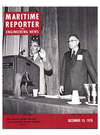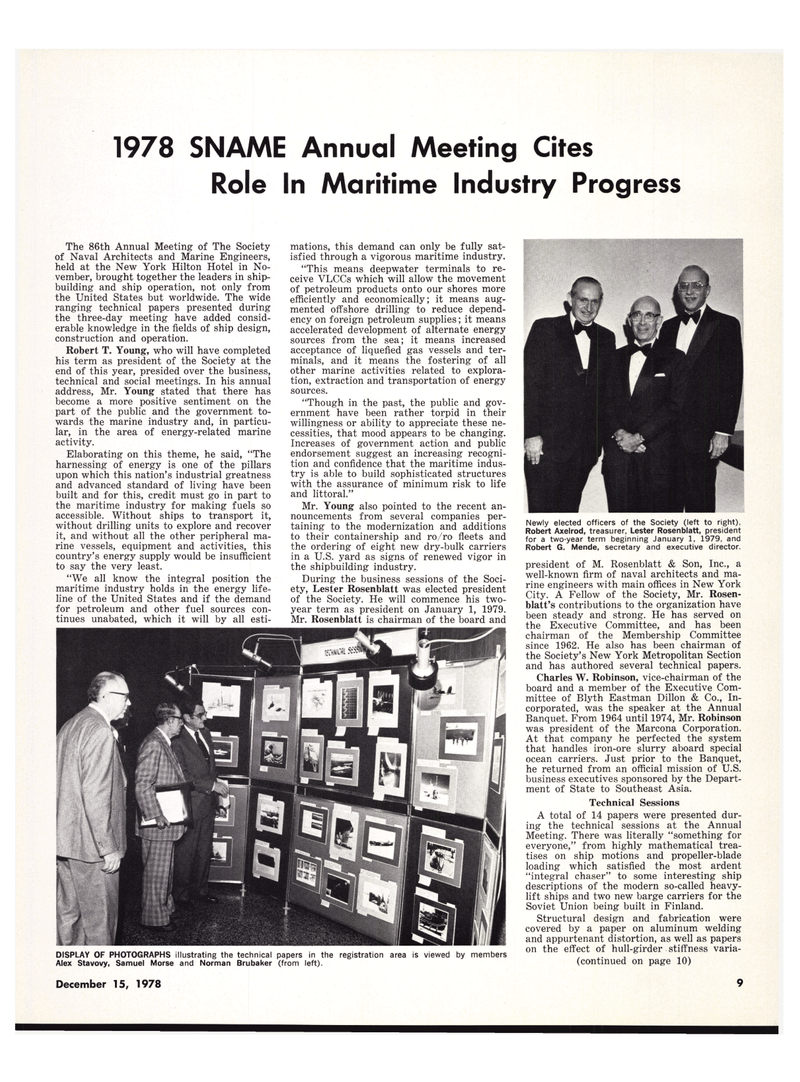
Page 11: of Maritime Reporter Magazine (December 15, 1978)
Read this page in Pdf, Flash or Html5 edition of December 15, 1978 Maritime Reporter Magazine
1978 SNAME Annual Meeting Cites
Role In Maritime Industry Progress
The 86th Annual Meeting of The Society of Naval Architects and Marine Engineers, held at the New York Hilton Hotel in No- vember, brought together the leaders in ship- building and ship operation, not only from the United States but worldwide. The wide ranging technical papers presented during the three-day meeting have added consid- erable knowledge in the fields of ship design, construction and operation.
Robert T. Young, who will have completed his term as president of the Society at the end of this year, presided over the business, technical and social meetings. In his annual address, Mr. Young stated that there has become a more positive sentiment on the part of the public and the government to- wards the marine industry and, in particu- lar, in the area of energy-related marine activity.
Elaborating on this theme, he said, "The harnessing of energy is one of the pillars upon which this nation's industrial greatness and advanced standard of living have been built and for this, credit must go in part to the maritime industry for making fuels so accessible. Without ships to transport it, without drilling units to explore and recover it, and without all the other peripheral ma- rine vessels, equipment and activities, this country's energy supply would be insufficient to say the very least. "We all know the integral position the maritime industry holds in the energy life- line of the United States and if the demand for petroleum and other fuel sources con- tinues unabated, which it will by all esti- mations, this demand can only be fully sat- isfied through a vigorous maritime industry. "This means deepwater terminals to re- ceive VLCCs which will allow the movement of petroleum products onto our shores more efficiently and economically; it means aug- mented offshore drilling to reduce depend- ency on foreign petroleum supplies; it means accelerated development of alternate energy sources from the sea; it means increased acceptance of liquefied gas vessels and ter- minals, and it means the fostering of all other marine activities related to explora- tion, extraction and transportation of energy sources. "Though in the past, the public and gov- ernment have been rather torpid in their willingness or ability to appreciate these ne- cessities, that mood appears to be changing.
Increases of government action and public endorsement suggest an increasing recogni- tion and confidence that the maritime indus- try is able to build sophisticated structures with the assurance of minimum risk to life and littoral."
Mr. Young also pointed to the recent an- nouncements from several companies per- taining to the modernization and additions to their containership and ro/ro fleets and the ordering of eight new dry-bulk carriers in a U.S. yard as signs of renewed vigor in the shipbuilding industry.
During the business sessions of the Soci- ety, Lester Rosenblatt was elected president of the Society. He will commence his two- year term as president on January 1, 1979.
Mr. Rosenblatt is chairman of the board and
December 15, 1978
Newly elected officers of the Society (left to right),
Robert Axelrod, treasurer, Lester Rosenblatt, president for a two-year term beginning January 1, 1979, and
Robert G. Mende, secretary and executive director. president of M. Rosenblatt & Son, Inc., a well-known firm of naval architects and ma- rine engineers with main offices in New York
City. A Fellow of the Society, Mr. Rosen- blatt's contributions to the organization have been steady and strong. He has served on the Executive Committee, and has been chairman of the Membership Committee since 1962. He also has been chairman of the Society's New York Metropolitan Section and has authored several technical papers.
Charles W. Robinson, vice-chairman of the board and a member of the Executive Com- mittee of Blyth Eastman Dillon & Co., In- corporated, was the speaker at the Annual
Banquet. From 1964 until 1974, Mr. Robinson was president of the Marcona Corporation.
At that company he perfected the system that handles iron-ore slurry aboard special ocean carriers. Just prior to the Banquet, he returned from an official mission of U.S. business executives sponsored by the Depart- ment of State to Southeast Asia.
Technical Sessions
A total of 14 papers were presented dur- ing the technical sessions at the Annual
Meeting. There was literally "something for everyone," from highly mathematical trea- tises on ship motions and propeller-blade loading which satisfied the most ardent "integral chaser" to some interesting ship descriptions of the modern so-called heavy- lift ships and two new barge carriers for the
Soviet Union being built in Finland.
Structural design and fabrication were covered by a paper on aluminum welding and appurtenant distortion, as well as papers on the effect of hull-girder stiffness varia- (continued on page 10) 11
DISPLAY OF PHOTOGRAPHS illustrating the technical papers in the registration area is viewed by members
Alex Stavovy, Samuel Morse and Norman Brubaker (from left).

 10
10

 12
12
